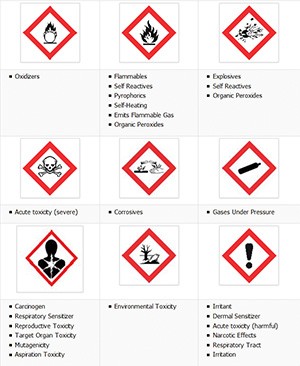ARE YOU READY FOR GHS?

On May 25, 2012, OSHA aligned the Hazard Communication Standard, 29 CFR 1910.1200 (HCS), with the United Nations Globally Harmonized System of Classification and Labeling of Chemicals , better known as GHS. By aligning HCS with GHS, OSHA aims to standardize the way information about chemical hazards is communicated to workers, employers, consumers, emergency responders, transporters, and anyone who might come in contact with these materials anywhere in the world.
The revised HCS transitions from a performance-based hazard classification with a general hazard determination and health hazard guidance to a uniformity-based system with a specific hazard classification, detailed health and physical hazard criteria and a new “hazard not otherwise classified” category.
GHS covers all hazardous chemical substances, dilute solutions and mixtures. Pharmaceuticals, food additives, cosmetics and pesticide residues in food are not be covered at the point of intentional intake, but are to be covered where workers may be exposed and in transport.
New Label Requirement

The first phase of GHS implementation required employers to train employees on new label requirements and Safety Data Sheets (SDS) format by December 1, 2013.
The new label format uses visual notations about chemical hazards to alert users, reduce confusion in the workplace and improve employee understanding of hazards. Labels for hazardous chemicals must include key elements:
- Product Identifier
- Contact Information
- Chemical Identity
- Standardized hazard pictograms/symbols
- Standardized signal words (Danger or Warning)
- Standardized hazard statement
- Precautionary statement (prevention, response, storage, disposal)
- Optional supplemental information
Safety Data Sheets
Under the updated HCS, Material Safety Data Sheets must be rewritten as Safety Data Sheets to provide a more complete resource for chemical hazard information. SDSs include 16 standardized and ordered sections to provide detailed chemical information in a consistent format that mirrors the American National Standard for Hazardous Workplace Chemical's Hazard Evaluation standard.
SDS Format: 16 Sections
- Identification
- Hazard(s) identification
- Composition - ingredient info
- First-aid measures
- Fire-fighting measures
- Accidental release measures
- Handling and storage
- Exposure control, PPE, exposure limits
- Physical and chemical properties
- Stability and reactivity
- Toxicological information
- Ecological information
- Disposal considerations
- Transport information
- Regulatory information
- Other
Timeline
The final HCS rule establishes specific target dates for GHS implementation and compliance:
- December 1, 2013: Employees had to be trained on the new label elements and SDS format.
- June 1, 2015: All chemicals manufactured after this date must have GHS labels applied and be accompanied by an SDS. Chemical producers, manufacturers, importers, and distributors may continue to ship products with the current labels until December 1, 2015.
- December 1, 2015: Distributors shall not ship containers labeled by the manufacturer or importer unless they have a GHS label.
- June 1, 2016: Employers must fully implement all GHS requirements including hazard classification, new labeling and training, update alternative workplace labeling and hazard communication program as necessary, and provide training for employees on the newly identified physical or health.
During the transition period to these dates, affected parties may comply with either the earlier 1994 HCS standard or the updated 2012 requirement.